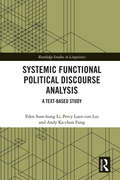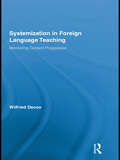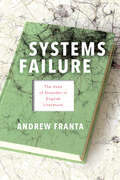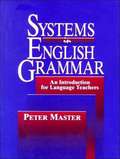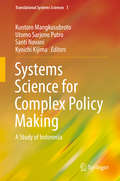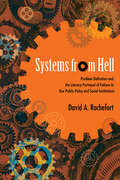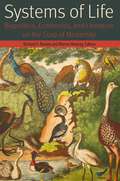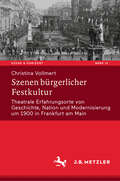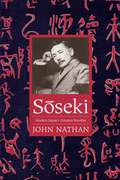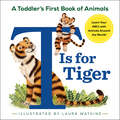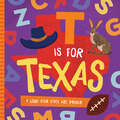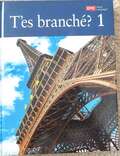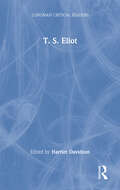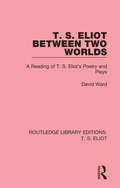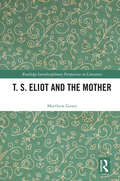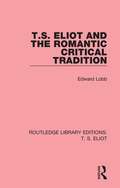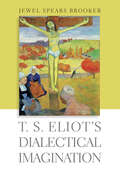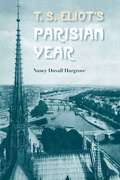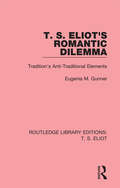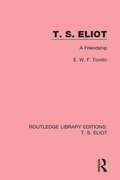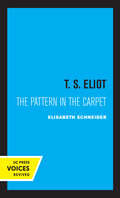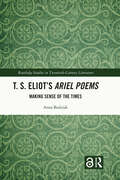- Table View
- List View
Systemic Functional Political Discourse Analysis: A Text-based Study (Routledge Studies in Linguistics)
by Eden Sum-hung Li Percy Luen-tim Lui Andy Ka-chun FungSystemic Functional Political Discourse Analysis: A Text-based Study is the first book which takes a comprehensive systemic functional perspective on political discourse to provide a complete, integrated, exhaustive, systemic and functional description and analysis. Based on the political discourses of the Umbrella Movement – the largest public protest in the history of Hong Kong, which occupies a unique political situation in the world: a post-colonial society like many other Asian societies and yet unlike the others, it is a Special Administrative Region of China. Though it enjoys a high degree of autonomy under the principle of ‘One Country, Two Systems’, it is still confined to being part of the ‘One Country’. The book demonstrates how a systemic functional approach can provide a comprehensive, thorough, and insightful analysis of the political discourse from four co-related and complementary approaches: contextual, discourse semantic, lexicogrammatical and historical. Apart from a thorough discussion of various systemic functional conceptions, it provides examples of various analyses from a SF perspective, including contextual parameters, registerial analysis, semantic discourse analysis, appraisal analysis, and discusses important issues in political discourse, including negotiation of self-identity, association of language, power and institutional role, and expression of ‘evidentiality’ and ‘subjectivity’. It is written not only for those who are interested in Hong Kong politics in general and political discourse in Hong Kong in particular, but also for those who work on political discourse analysis, and those who apply SFL to various other discourses such as mass media discourse, medical discourse, teaching discourse, etc. Last but not least, this book is also intended to provide a theoretical framework in discourse analysis from the systemic functional perspective for those who work in Cantonese and in other languages.
Systemization in Foreign Language Teaching: Monitoring Content Progression (Routledge Research in Education)
by Wilfried DecooForeign language learning is a progressive endeavor. Whatever the method, the learner should advance from one point to another, constantly improving. Growing proficiency entails growing language content. Content is complex, displaying many dimensions. Syllabus designers, textbook authors, and teachers often struggle with the monitoring of content. Computer-assisted systemization helps to handle it in a manageable framework. Besides inventorying content, it ensures more balanced selections, calculated progression, and controlled reiteration of previously learned material. It gauges the usability of authentic material in relation to the level attained. During the teaching process, it allows the instant selection of items needed for a communicative situation, focus on forms, or particular exercises. This book first describes the theoretical background for systemization, including a historical overview, with special attention to the Common European Framework and the new Profiles and Referentials. Next the practical steps for computer-assisted implementation with examples taken from French and English, but applicable to any language.
Systems Failure: The Uses of Disorder in English Literature
by Andrew FrantaHow eighteenth-century writers stretched systems designed to explain social relations to their breaking point, showing the flaws in their design.The Enlightenment has long been understood—and often understood itself—as an age of systems. In 1759, Jean Le Rond d'Alembert, one of the architects of the Encyclopédie, claimed that "the true system of the world has been recognized, developed, and perfected." In Systems Failure, Andrew Franta challenges this view by exploring the fascination with failure and obsession with unpredictable social forces in a range of English authors from Samuel Johnson to Jane Austen.Franta argues that attempts to extend the Enlightenment's systematic spirit to the social world prompted many prominent authors to reject the idea that knowledge is synonymous with system. In readings of texts ranging from novels by Sterne, Smollett, Godwin, and Austen to Johnson's literary biographies and De Quincey's periodical essays, Franta shows how writers repeatedly take up civil and cultural institutions designed to rationalize society only to reveal the weaknesses that inevitably undermine their organizational and explanatory power. Diverging from influential accounts of the rise of the novel, Systems Failure audaciously reveals that, in addition to representing individual experience and social reality, the novel was also a vehicle for thinking about how the social world resists attempts to explain or comprehend it. Franta contends that to appreciate the power of systems in the literature of the long eighteenth century, we must pay attention to how often they fail—and how many of them are created for the express purpose of failing. In this unraveling, literature arrives at its most penetrating insights about the structure of social life.
Systems In English Grammar: An Introduction For Language Teachers
by Peter MasterThis book teaches teachers how to present grammar lessons to their students with confidence and clarity. Introduces future teachers of English to the major elements of English grammar in a systematic fashion, using step-by-step procedures, charts, diagrams, and exercises. Includes a complete answer key to exercises.
Systems Science for Complex Policy Making: A Study of Indonesia (Translational Systems Sciences #3)
by Kuntoro Mangkusubroto Utomo Sarjono Putro Santi Novani Kyoichi KijimaThis volume applies a systems science perspective to complex policy making dynamics, using the case of Indonesia to illustrate the concepts. Indonesia is an archipelago with a high heterogeneity. Her people consist of 1,340 tribes who are scattered over 17,508 islands. Every region has different natural strengths and conditions. In the national development process all regions depend on one another other while optimizing their own conditions. In addition to this diversity, Indonesia also employs a democratic system of government with high regional autonomy. A democratic government puts a high value on individual freedom, but on the other hand, conflicts of interest also occur frequently. High regional autonomy also often causes problems in coordination among agencies and regional governments. This uniqueness creates a kind of complexity that is rarely found in other countries.These daily complexities requires intensive interaction, negotiation processes, and coordination. Such necessities should be considered in public policy making and in managing the implementation of national development programs. In this context, common theories and best practices generated on the basis of more simplified assumptions often fail. Systems science offer a way of thinking that can take into account and potentially overcome these complexities. However, efforts to apply systems science massively and continuously in real policy making by involving many stakeholders are still rarely carried out. The first part of the book discusses the gap between the existing public policy-making approach and needs in the real world. After that, the characteristics of the appropriate policy-making process in a complex environment and how this process can be carried are described. In later sections, important systems science concepts that can be applied in managing these complexities are discussed. Finally, the efforts to apply these concepts in real cases in Indonesia are described.
Systems from Hell: Problem Definition and the Literary Portrayal of Failure in Our Public Policy and Social Institutions (SUNY series in New Political Science)
by David A. RochefortThis book approaches contemporary fiction as a medium for policy advocacy, one whose narrative devices both link it to, and distinguish it from, other forms of public discourse. Using the framework of political agenda setting, David A. Rochefort analyzes the rhetorical function of problem definition played by literary works when they document and characterize social issues while sounding the call for systemic reform. Focusing on a group of noteworthy realist novels by American authors over the past twenty years, this study maintains that fictional narrative is a potentially influential instrument of "empathic policy argument." The book closes by examining the agenda-setting dynamics through which a social problem novel can contribute to the process of policy change.
Systems of Life: Biopolitics, Economics, and Literature on the Cusp of Modernity (Forms of Living)
by Richard A. Barney and Warren MontagSystems of Life offers a wide-ranging revaluation of the emergence of biopolitics in Europe from the mid– eighteenth to the mid–nineteenth century. In staging an encounter among literature, political economy, and the still emergent sciences of life in that historical moment, the essays collected here reopen the question of how concepts of animal, vegetable, and human life, among other biological registers, had an impact on the Enlightenment project of thinking politics and economics as a joint enterprise. The volume’s contributors consider politics, economics, and the biological as distinct, semi-autonomous spheres whose various combinations required inventive, sometimes incomplete, acts of conceptual mediation, philosophical negotiation, disciplinary intervention, or aesthetic representation.
Szenen bürgerlicher Festkultur: Theatrale Erfahrungsorte von Geschichte, Nation und Modernisierung um 1900 in Frankfurt am Main (Szene & Horizont. Theaterwissenschaftliche Studien #12)
by Christina VollmertAm Beispiel der Stadt Frankfurt a.M. untersucht die interdisziplinäre Studie anhand dreier Fallstudien das komplexe Verhältnis zwischen gesellschaftlichen, politischen und medienkulturellen Transformationsprozessen und bürgerlicher Festkultur als Ort sozialer Bedeutungskonstruktion. Von historischen Stadt- und Künstlerfesten über politisch aufgeladene Schützenfeste bis hin zu spektakulären Industrie- und Gewerbeausstellungen werden die untersuchten Feste als theatrale Aufführungen verstanden, die die Veränderungen der Modernisierung um 1900 reflektieren und tiefe Einblicke in die soziokulturellen Umbrüche jener Zeit ermöglichen. Das Theatrale als bewusste und demonstrative Betonung des Zur-Schau-Stellens wird in dieser Studie als kulturelle Praxis gedeutet, die als Vermittler in einer Zeit der Umbrüche agieren kann: Indem die analysierten Feste abstrakte und ideologisch aufgeladene Konzepte wie Geschichte, Nation oder Modernisierung im Moment ihrer sinnlichen Zurschaustellung unmittelbar erfahrbar machen, ermöglichen sie eine Teilhabe an einem ästhetischen Erlebnis, das zum Verständnis und zur Akzeptanz der vermittelten Inhalte führen kann. Die Studie eröffnet damit eine neue Perspektiven auf die bislang gängigen Narrative der Kultur- und Modernisierungsgeschichte des 19. Jahrhunderts.
Sōseki: Modern Japan's Greatest Novelist (Asia Perspectives: History, Society, and Culture)
by John NathanNatsume Sōseki (1867–1916) was the father of the modern novel in Japan, chronicling the plight of bourgeois characters caught between familiar modes of living and the onslaught of Western values and conventions. Yet even though generations of Japanese high school students have been expected to memorize passages from his novels and he is routinely voted the most important Japanese writer in national polls, he remains less familiar to Western readers than authors such as Kawabata, Tanizaki, and Mishima.In this biography, John Nathan provides a lucid and vivid account of a great writer laboring to create a remarkably original oeuvre in spite of the physical and mental illness that plagued him all his life. He traces Sōseki’s complex and contradictory character, offering rigorous close readings of Sōseki’s groundbreaking experiments with narrative strategies, irony, and multiple points of view as well as recounting excruciating hospital stays and recurrent attacks of paranoid delusion. Drawing on previously untranslated letters and diaries, published reminiscences, and passages from Sōseki’s fiction, Nathan renders intimate scenes of the writer’s life and distills a portrait of a tormented yet unflaggingly original author. The first full-length study of Sōseki in fifty years, Nathan’s biography elevates Sōseki to his rightful place as a great synthesizer of literary traditions and a brilliant chronicler of universal experience who, no less than his Western contemporaries, anticipated the modernism of the twentieth century.
T Is for Tiger: A Toddler's First Book of Animals
by Laura WatkinsFrom alligator to zebra—wild animals make learning the alphabet come alive for kids ages 2 to 4What could be more fun than learning about the alphabet and all sorts of amazing animals at the same time? T Is for Tiger goes beyond other animal books for toddlers and introduces your little one to letters in an simple and fascinating format with colorful illustrations and plenty of critters they'll never forget.Everything animal books for toddlers should be:A worldwide adventure—Discover animals for every letter of the alphabet—even Q and X—as they appear in their natural environments.Engaging and educational—Unlike other animal books for toddlers, T Is for Tiger features realistic illustrations that help your toddler recognize animals and their homes.Go beyond the ABCs—You won't need other animal books for toddlers—revisit the pages and continue the learning as your child grows with animal fun facts, a world map, and more.Teach your little one about letters and animals all at once—from A is for alligator to Z is for zebra. When it comes to animal books for toddlers, this one roars with fun.
T is for Texas: A Lone Star State ABC Primer
by Trish MadsonTake an alphabetized field trip around the Lone Star State and discover the plants, animals, foods, and places that make it, well, Texas!
T is for Turkey: A True Thanksgiving Story
by Tanya Lee StoneLittle ones will love learning about Thanksgiving in Tanya Lee Stone's newest shaped alphabet book. Join in as the elementary school puts on a play that tells the true story of the first Thanksgiving. Rhyming couplets that flow through the alphabet help kids celebrate everything from Harvest to Pilgrims to Turkey.
T. S. Eliot (Longman Critical Readers)
by Harriet DavidsonOne of the most influential poets of the twentieth century, T. S. Eliot is generally regarded as a leading exponent of the literary movement which came to be known as Modernism. In this volume, Harriet Davidson collects key recent essays by such internationally renowned critics as Terry Eagleton, Sandra Gilbert, Jacqueline Rose, Jeffrey Perl, Christine Froula, Maud Ellmann, and Michael North, placing Eliot's work centrally in the context of postmodern critical theory.Eliot's writing is often perceived as incompatible with or resistant to new theoretical approaches, but this volume demonstrates the continuity between Eliot's own theoretical writings and contemporary theory, and illuminates his poetry with imaginative readings from deconstructive, Marxist, psychoanalytic, and feminist perspectives. Headnotes to the essays and a bibliography which lists other informative readings make this book an invaluable guide to all students of twentieth-century poetry, and to scholars interested in the relationship between critical and creative writing.
T. S. Eliot Between Two Worlds: A Reading of T. S. Eliot's Poetry and Plays (Routledge Library Editions: T. S. Eliot #10)
by David WardThe basis of this critical examination of Eliot’s work, first published in 1973, is the investigation of his transmutation of this and other philosophical, mythological and religious motives into the textures of his verse. This book focuses on Eliot’s peculiar eclectic approach to what he described as ‘the Tradition’. It also recognises the fact that Eliot, for all his attempts at universality, was a product of time and place, and gives an account of the way in which his education and experience shaped his most important interests. This title will be of interest to students of literature.
T. S. Eliot and the Mother (Routledge Interdisciplinary Perspectives on Literature)
by Matthew GearyThe first full-length study on T. S. Eliot and the mother, this book responds to a shortfall in understanding the true importance of Eliot’s poet-mother, Charlotte Champe Stearns, to his life and works. In doing so, it radically rethinks Eliot’s ambivalence towards women. In a context of mother–son ambivalence (simultaneous feelings of love and hate), it shows how his search for belief and love converged with a developing maternal poetics. Importantly, the chapters combine standard literary critical methods and extensive archival research with innovative feminist, maternal and psychoanalytic theorisations of mother–child relationships, such as those developed by Julia Kristeva, Luce Irigaray, Jessica Benjamin, Jan Campbell and Rozsika Parker. These maternal thinkers emphasise the vital importance and benefit of recognising the pre-Oedipal mother and maternal subjectivity, contrary to traditional, repressive Oedipal models of masculinity. Through this interdisciplinary approach, the chapters look at Eliot’s changing representations and articulations of the mother/ mother–child relationship from his very earliest writings through to the later plays. Focus is given to decisive mid-career works: Ash-Wednesday (1930), ‘Marina’ (1930), ‘Coriolan’ (1931–32) and The Family Reunion (1939), as well as to canonical works The Waste Land (1922) and Four Quartets (1943). Notably, the study draws heavily on the wide range of Eliot materials now available, including the new editions of the complete poems, the complete prose and the volumes of letters, which are transforming our perception of the poet and challenging critical attitudes. The book also gives unprecedented attention to Charlotte Eliot’s life and writings and brings her individual female experience and subjectivity to the fore. Significantly, it establishes Charlotte’s death in 1929 as a decisive juncture, marking both Eliot’s New Life and the apotheosis of the feminine symbolised in Ash-Wednesday. Central to this proposition is Geary’s new formulation for recognising and examining a maternal poetics, which also compels a new concept of maternal allegory as a modern mode of literary epiphany. T. S. Eliot and the Mother reveals the role of the mother and the dynamics of mother–son ambivalence to be far more complicated, enduring, changeable and essential to Eliot’s personal, religious and poetic development than previously acknowledged.
T. S. Eliot and the Romantic Critical Tradition (Routledge Library Editions: T. S. Eliot #5)
by Edward LobbEdward Lobb’s study, first published in 1981, is a thorough examination of Eliot’s relation to Romantic criticism. This title also makes extensive use of Eliot’s Clark Lectures on metaphysical poetry. Delivered in 1926, the lectures complete the picture of literary history set out in Eliot’s published work, and are, the author believes, essential to a full understanding of the poet’s ideas and their place in tradition. Drawing on a wide variety of primary sources and earlier scholarship, T. S. Eliot and the Romantic Critical Tradition will be of interest to students of literature.
T. S. Eliot in Context
by Jason HardingT. S. Eliot's work demands much from his readers. The more the reader knows about his allusions and range of cultural reference, the more rewarding are his poems, essays and plays. This book is carefully designed to provide an authoritative and coherent examination of those contexts essential to the fullest understanding of his challenging and controversial body of work. It explores a broad range of subjects relating to Eliot's life and career; key literary, intellectual, social and historical contexts; as well as the critical reception of his oeuvre. Taken together, these chapters sharpen critical appreciation of Eliot's writings and present a comprehensive, composite portrait of one of the twentieth century's pre-eminent men of letters. Drawing on original research, T. S. Eliot in Context is a timely contribution to an exciting reassessment of Eliot's life and works, and will provide a valuable resource for scholars, teachers, students and general readers.
T. S. Eliot's Dialectical Imagination (Hopkins Studies in Modernism)
by Jewel Spears BrookerWhat principles connect—and what distinctions separate—"The Love Song of J. Alfred Prufrock," The Waste Land, and Four Quartets?The thought-tormented characters in T. S. Eliot’s early poetry are paralyzed by the gap between mind and body, thought and action. The need to address this impasse is part of what drew Eliot to philosophy, and the failure of philosophy to appease his disquiet is the reason he gave for abandoning it. In T. S. Eliot’s Dialectical Imagination, Jewel Spears Brooker argues that two of the principles that Eliot absorbed as a PhD student at Harvard and Oxford were to become permanent features of his mind, grounding his lifelong quest for wholeness and underpinning most of his subsequent poetry. The first principle is that contradictions are best understood dialectically, by moving to perspectives that both include and transcend them. The second is that all truths exist in relation to other truths. Together or in tandem, these two principles—dialectic and relativism—constitute the basis of a continual reshaping of Eliot’s imagination. The dialectic serves as a kinetic principle, undergirding his impulse to move forward by looping back, and the relativism supports his ingrained ambivalence. Brooker considers Eliot’s poetry in three blocks, each represented by a signature masterpiece: "The Love Song of J. Alfred Prufrock," The Waste Land, and Four Quartets. She correlates these works with stages in the poet’s intellectual and spiritual life: disjunction, ambivalence, and transcendence. Using a methodology that is both inductive—moving from texts to theories—and comparative—juxtaposing the evolution of Eliot’s mind as reflected in his philosophical prose and the evolution of style as seen in his poetry—Brooker integrates cultural and biographical contexts. The first book to read Eliot’s poems alongside all of his prose and letters, T. S. Eliot’s Dialectical Imagination will revise received readings of his mind and art, as well as of literary modernism.
T. S. Eliot's Parisian Year
by Nancy Duvall HargroveAfter graduating from Harvard in 1910, T. S. Eliot spent a year in Paris, and his experiences there had a profound and lasting influence upon his life and his work. Even so, most scholars and biographers ignore it, mention it only in passing, or, in rare cases, dismiss it as a typical post-graduation year any wealthy student of the time could have had. <P><P> Nancy Hargrove sets the record straight on just how vitally important this period was for the young man. She meticulously re-creates the city and discusses in detail how pre-war Parisian culture influenced the works Eliot later produced. Hers is the first in-depth study of this crucial but largely overlooked year in the life of the artist, and reveals the complex repercussions it had on his literary career. <P><P> Nancy Duvall Hargrove, author of Landscape as Symbol in the Poetry of T. S. Eliot, is William L. Giles Distinguished Professor Emerita of English at Mississippi State University.
T. S. Eliot's Romantic Dilemma: Tradition's Anti-Traditional Elements (Routledge Library Editions: T. S. Eliot #4)
by Eugenia M. GunnerThe fact that Eliot disapproved of Romanticism is clear from his critical essays, where he often appears to reject it absolutely. However, Eliot’s understanding of the term and his appreciation of literature developed and altered greatly from his adolescence to his years of scholarly study, yet he was never unable to dismiss Romanticism entirely as a critical issue. This study, first published in 1985, analyses Eliot’s approach and criticism to Romanticism, with an analysis of The Waste Land, adding to the layers of its meaning, context and content to the poem. This title will be of interest to students of literature.
T. S. Eliot: A Friendship (Routledge Library Editions: T. S. Eliot)
by Frederick TomlinFirst published in 1988. Fredrick Tomlin and T. S. Eliot were friends for almost thirty-four years. What emerges from Fredrick Tomlin’s memories and the many letters which passed between them is a private Eliot, seen only by his closest family and a trusted few. Tomlin evokes the man as he was – quite different in his humanity and in his humour from the public image of the ‘great poet’ and the austere sage. With fresh insights and personal testimony, Tomlin directs light onto aspects of Eliot’s character and personality of which the public has been unaware, thereby enhancing the reader’s appreciation of Eliot’s work as a whole. This title will be of interest to students of literature.
T. S. Eliot: The Pattern in the Carpet
by Elisabeth W. SchneiderThis title is part of UC Press's Voices Revived program, which commemorates University of California Press’s mission to seek out and cultivate the brightest minds and give them voice, reach, and impact. Drawing on a backlist dating to 1893, Voices Revived makes high-quality, peer-reviewed scholarship accessible once again using print-on-demand technology. This title was originally published in 1975.
T. S. Eliot’s Ariel Poems: Making Sense of the Times (Routledge Studies in Twentieth-Century Literature)
by Anna BudziakT. S. Eliot once stated that the supreme poet "in writing himself, writes his time". In saying that, he honoured Dante and Shakespeare, but this pithy remark fittingly characterises his own work, including The Ariel Poems, with which he promptly and pointedly responded to the problems of his times. Published with unwavering regularity, a poem a year, the Ariels were composed in the period when Eliot was mainly writing prose; and, like his prose, they reverberated with diverse contemporary issues ranging from the revision of the Book of Common Prayer to the translations of Heidegger to the questions of leadership and populism. In order to highlight the poems' historical specificity, this study seeks to outline the constellations of thought connecting Eliot’s poetry and prose. In addition, it attempts to expose the Ariels’ shared arc of meaning, an unobtrusive incarnational metaphor determining the perspective from which they propose an unorthodox understanding of the epoch— an underlying pattern of thought bringing them together into a conceptually discrete set. This is the first study that both universalizes and historicises the series, striving to disclose the regular without suppressing the random. Approaching the series as a system of orderly disorder, the notion very much at home with chaos theory, it suggests new intellectual contexts, offering interpretations that are either fresh, or significantly reangled.
